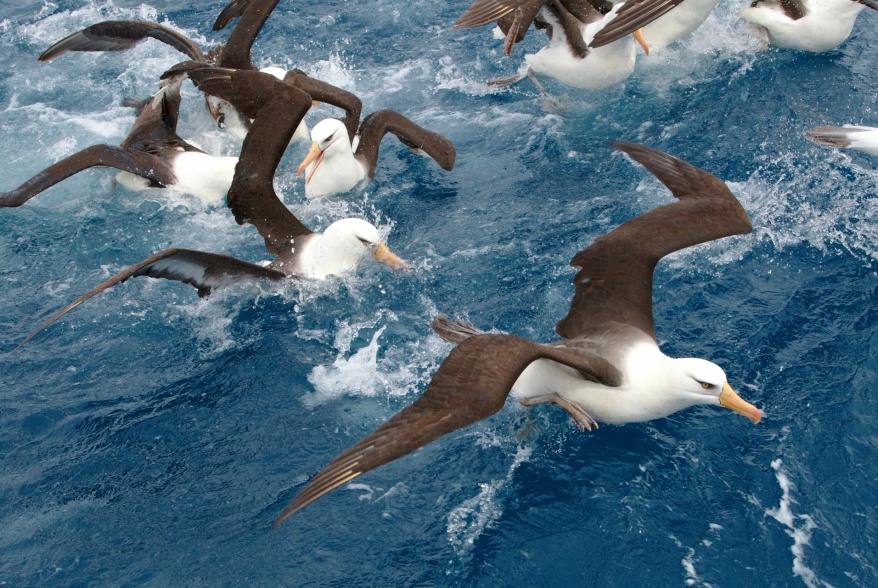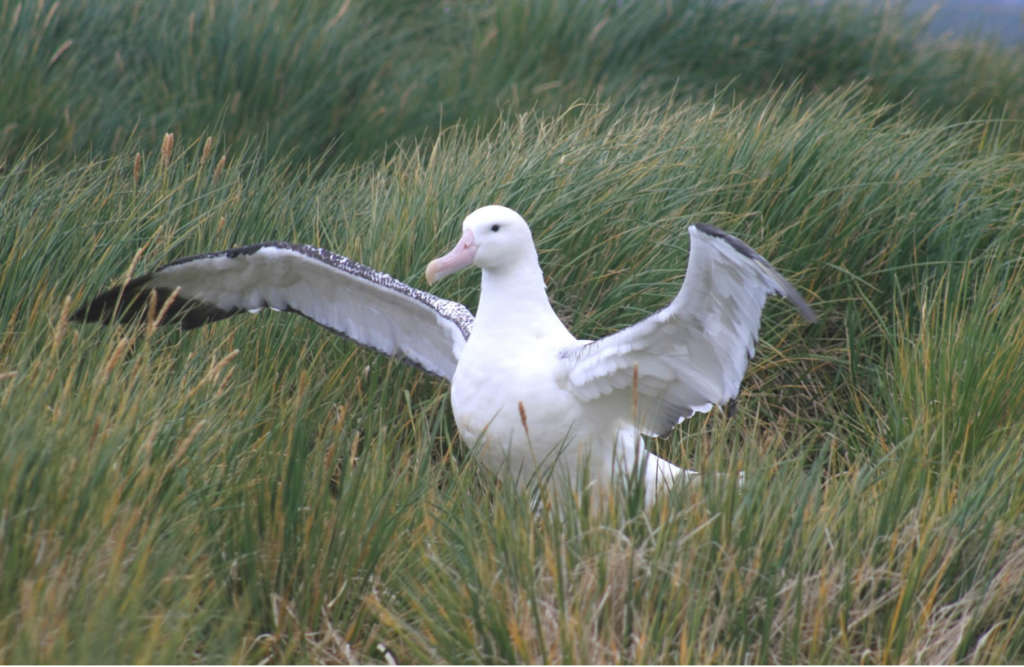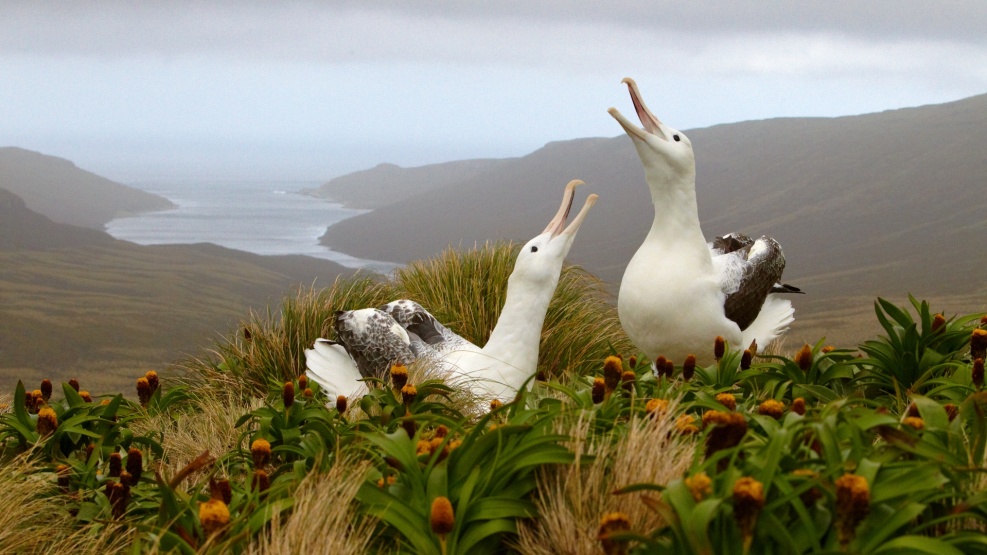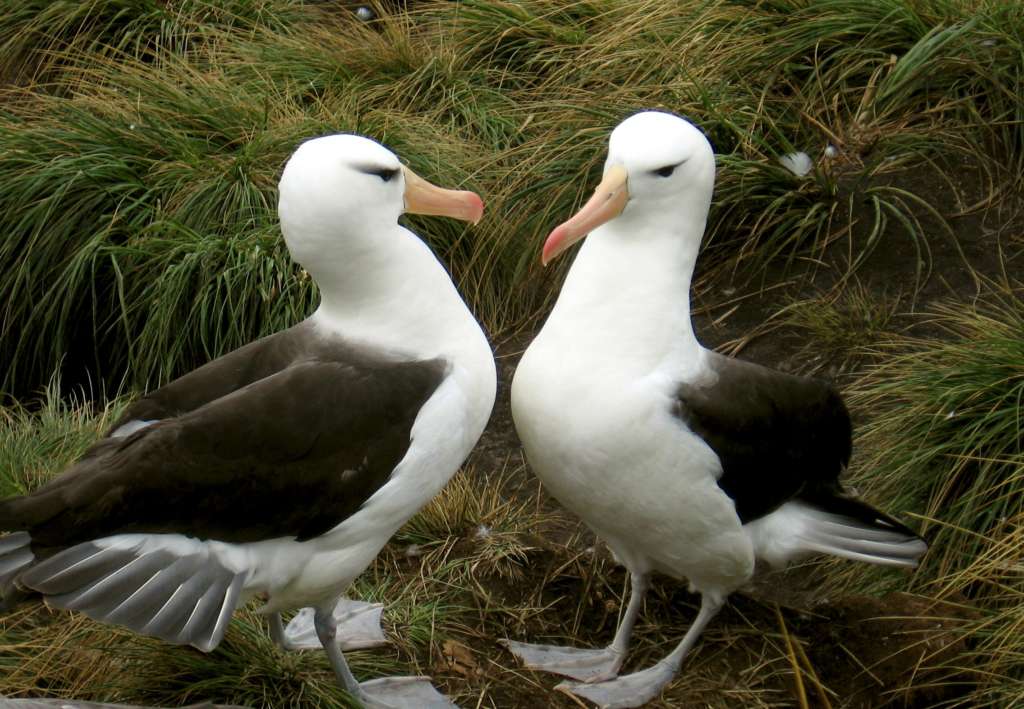The Awe-Inspiring Albatross

by Noah Patton
Albatross are large seabirds, known for their wingspan, efficacy in the air, and their threatened status as a result of human longline fishing.
Various species of Albatross range across the Southern Ocean and the Northern Pacific Ocean and are entirely absent from the Northern Atlantic Ocean. Most species exist in the Southern Ocean, except for four North Pacific species, including the waved albatross which breeds on the Galápagos Islands. Albatross generally require higher latitudes – wind is a crucial aspect of their flight. The waved albatross can survive on a central latitude due to the cool waters of the Humboldt Current near the Galápagos Island creating favourable wind. [1]

Albatross are made to glide. Their wingspans are the largest of any extant bird species in the world, reaching lengths up to 3.7 metres. [2] The tubes along the side of their bills are also very important to their flight, although these are nostrils, they work in the same way pilot tubes work in an aircraft. It allows the bird to accurately know their airspeed, so they can perform an air technique known as dynamic soaring. This is where the bird repeatedly rises with the wind and dives, gaining velocity and distance each time it repeats the process. This technique requires only slight adjustments in the wings of the birds to turn, conserving energy that would otherwise need to be spent flapping their wings. This in combination with slope soaring, where the bird uses rising air currents in the wake of large wives to gain considerable height, enables albatross to travel over 1000km a day – without flapping their wings once. [3] These techniques, particularly dynamic soaring, are being adapted into our own aircrafts. Aerospace engineers are studying albatross flight patterns, hoping to apply it to drones to drastically reduce the energy required to keep them in the air. [4]

This efficient method of travel allows the albatross to cross massive distances to find rich feeding areas. Because of this albatross are often spread far apart across oceans, only regrouping in large colonies to breed.
They usually feed on cephalopods, fish, crustaceans or offal from scavenged carrion. Some species focus mostly on squid, some krill, others entirely on fish. It is difficult to log their feeding habits due to the vast distributions of the albatross. They were once thought to be surface feeders, only eating fish and krill forced to the surface by ocean currents or predators below but have recently been observed diving below the surface to catch their prey. The waved albatross has even been observed harassing boobies away from their food, stealing their kills, this is a form of kleptoparasitism (parasitism by theft). [5]

However when it reaches their breeding season, albatross will return to their colony and all feed on the surrounding areas. Albatross can live for up to 66 years, and live on average to their early 50s. It takes an albatross 10 years to begin breeding, they spend much of their youth learning to dance – the species breeding ritual. Eventually they will perfect their dance, learning from older birds and years of practice with dance partners. Once they have chosen a partner an unbreakable bond is formed, they will continue to pair for the rest of their lives, perfecting their own dance unique to that pair. This process is convoluted and difficult for a reason, raising a baby albatross is a demanding task. Albatross will only lay a single egg if they choose to breed that year, if the egg is broken or lost to predators they will not attempt to breed until the next year. The egg incubates for a few months, with parents taking shifts to replenish their energy. Once the chick has hatched parents will take it in turns to guard their chick, with the other parent out hunting returning to feed the chick. For some species it can take 140 days to reach independence, for the larger species it takes up to 280 days. [6]
Like many species of animals, albatross face significant threats as a result of human interference. Long-line fishing is the primary threat, causing an estimated 100,000 albatross deaths each year. The birds are attracted to the bait, if they are caught by it, they drown. Agreements have been made by major countries to mitigate and reduce the danger to the species, but all species of albatross are still endangered to some degree. Even more distressing is the birds ingesting plastic debris. With the large amount of plastic in the sea the birds occasionally eat the plastic, mistaking it for prey. This is bad for the albatross, causing declining body weight and health, but albatross also regurgitate the plastic feeding it to their chick. This causes the chick stress and to feel always full, reducing the amount of food it eats, significantly reducing its chance of survival.[7]
We all have the power to make individual difference and change, little things like reducing the amount of plastic we use, recycling correctly and ensuring we dispose of rubbish all help to reduce the environmental impact we have on our natural world.
Bibliography:
- [1] Brooke, M. (2004). Albatrosses and Petrels Across the World Oxford University Press, Oxford, UK ISBN 0-19-850125-0
- [2] Humann, Alec; Brinkley, Edward S. (2001). “Albatrosses”. In Elphick, Chris; Dunning Jr., John B.; Sibley, David Allen (eds.). The Sibley Guide to Bird Life and Behavior. illustrated by David Allen Sibley (1st. ed.). New York: Alfred A. Knopf. pp. 132–135. ISBN 978-0-679-45123-5.
- [3] Brooke, M. (2004). Albatrosses and Petrels Across the World
- [4] Daniel Stone (7 September 2012). “Albatross’s Effortless Flight Decoded—May Influence Future Planes”. National Geographic.
- [5] Spear, Larry; David G. Ainley (1993). “Kleptoparasitism by Kermadec Petrels, Jaegers, and Skuas in the Eastern Tropical Pacific: Evidence of Mimicry by Two Species of Pterodroma”. The Auk. 110 (2): 222–233. JSTOR 4088550.
- [6] Carboneras, C. (1992) “Family Diomedeidae (Albatross)” in Handbook of Birds of the World Vol 1. Barcelona:Lynx Edicions, ISBN 84-87334-10-5
- [7] Auman, H.J., Ludwig, J.P., Giesy, J.P., Colborn, T., (1997) “Plastic ingestion by Laysan Albatross chicks on Sand Island, Midway Atoll, in 1994 and 1995.” Archived 2005-10-30 at the Wayback Machine in Albatross Biology and Conservation, (ed by G. Robinson and R. Gales). Surrey Beatty & Sons:Chipping Norton. pp. 239–44

